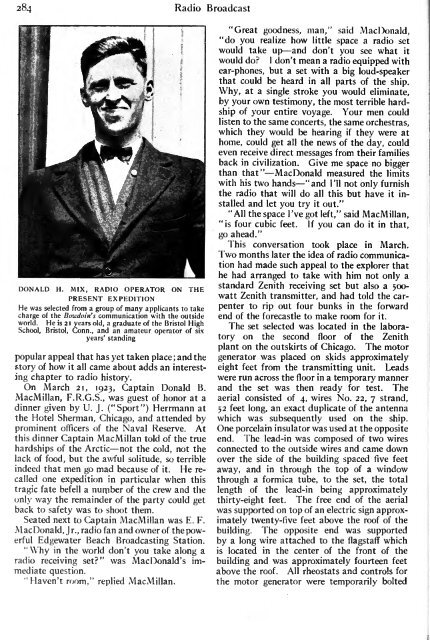Radio Broadcast - 1923, August - 86 Pages, 8.5 ... - VacuumTubeEra
Radio Broadcast - 1923, August - 86 Pages, 8.5 ... - VacuumTubeEra
Radio Broadcast - 1923, August - 86 Pages, 8.5 ... - VacuumTubeEra
- No tags were found...
You also want an ePaper? Increase the reach of your titles
YUMPU automatically turns print PDFs into web optimized ePapers that Google loves.
284 <strong>Radio</strong> <strong>Broadcast</strong>DONALD H. MIX, RADIO OPERATOR ON THEPRESENT EXPEDITIONHe was selected from a group of many applicants to takecharge of the Bowdoin's communication with the outsideworld. He is 2i years old, a graduate of the Bristol HighSchool, Bristol, Conn., and an amateur operator of sixyears' standingpopular appeal that has yet taken place; and thestory of how it all came about adds an interestingchapter to radio history.On March 21, <strong>1923</strong>, Captain Donald B.MacMillan, F.R.G.S., was guest of honor at adinner given by U. J. ("Sport") Herrmann atthe Hotel Sherman, Chicago, and attended byprominent officers of the Naval Reserve. Atthis dinner Captain MacMillan told of the truehardships of the Arctic not the cold, not thelack of food, but the awful solitude, so terribleindeed that men go mad because of it. He recalledone expedition in particular when thistragic fate befell a nurnber of the crew and theonly way the remainder of the party could getback to safety was to shoot them.Seated next to Captain MacMillan was E. F.MacDonald, Jr., radio fan and owner of the powerfulEdgewater Beach <strong>Broadcast</strong>ing Station."Why inthe world don't you take along aradio receiving set?" was Mac Donald's immediatequestion."Haven't room," replied MacMillan."Great goodness, man," said MacDonald,"do you realize how little space a radio setwould take up and don't you see what itwould do? 1 don't mean a radio equipped withear-phones, but a set with a big loud-speakerthat could be heard in all parts of the ship.Why, at a single stroke you would eliminate,by your own testimony, the most terrible hardshipof your entire voyage. Your men couldlisten to the same concerts, the same orchestras,which they would be hearingifthey were athome, could get all the news of the day, couldeven receive direct messages from their familiesback in civilization. Give me space no biggerthan that" MacDonald measured the limitswith his two hands "and I'll not only furnishthe radio that will do all this but have it installedand let you tryit out.""All the space I've got left," said MacMillan,"is four cubic feet. Ifyou can do it in that,go ahead."This conversation took place in March.Two months later the idea of radio communicationhad made such appeal to the explorer thathe had arranged to take with him not only astandard Zenith receiving set but also a 500-watt Zenith transmitter, and had told the carpenterto rip out four bunks in the forwardend of the forecastle to make room for it.The set selected was located in the laboratoryon the second floor of the Zenithplant on the outskirts of Chicago. The motorgenerator was placed on skids approximatelyeight feet from the transmitting unit. Leadswere run across the floor in a temporary mannerand the set was then ready for test. Theaerial consisted of 4, wires No. 22, 7 strand,52 feet long, an exact duplicate of the antennawhich was subsequently used on the ship.One porcelain insulator was used at the oppositeend. The lead-in was composed of two wiresconnected to the outside wires and came downover the side of the building spaced five feetaway, and in through the top of a windowthrough a formica tube, to the set, the totallength of the lead-in being approximatelythirty-eight feet. The free end of the aerialwas supported on top of an electric sign approximatelytwenty-five feet above the roof of thebuilding. The opposite end was supportedby a long wire attached to the flagstaff whichis located in the center of the front of thebuilding and was approximately fourteen feetabove the roof. All rheostats and controls forthe motor generator were temporarily bolted
















